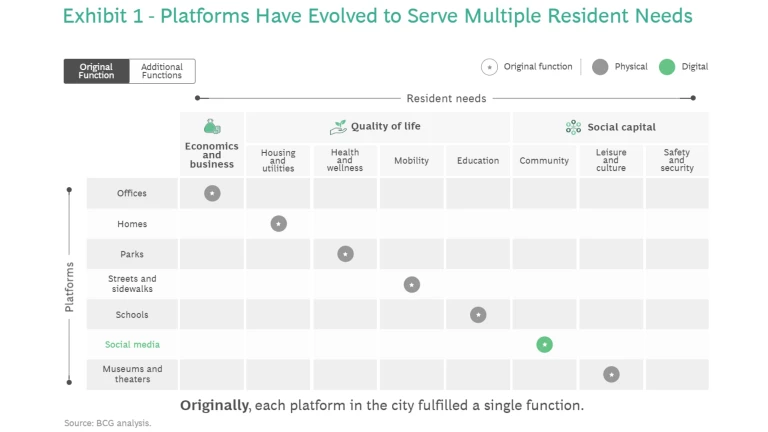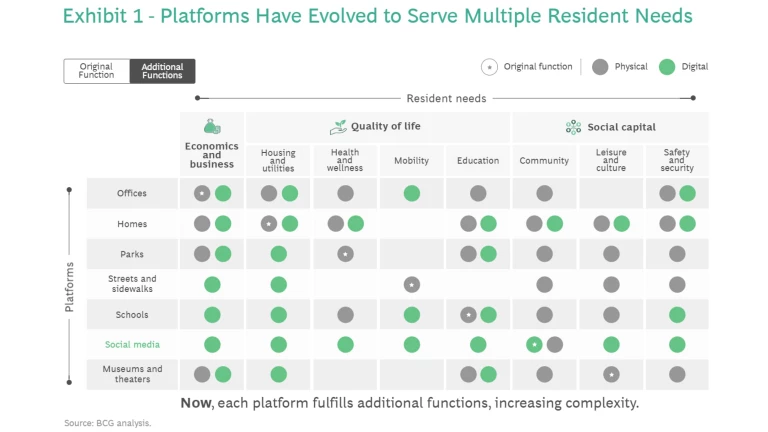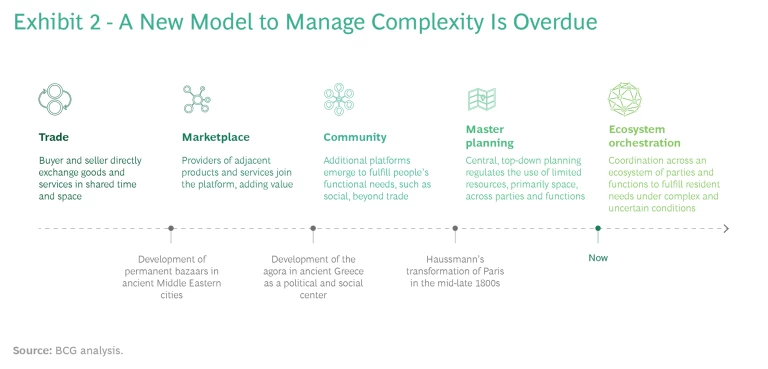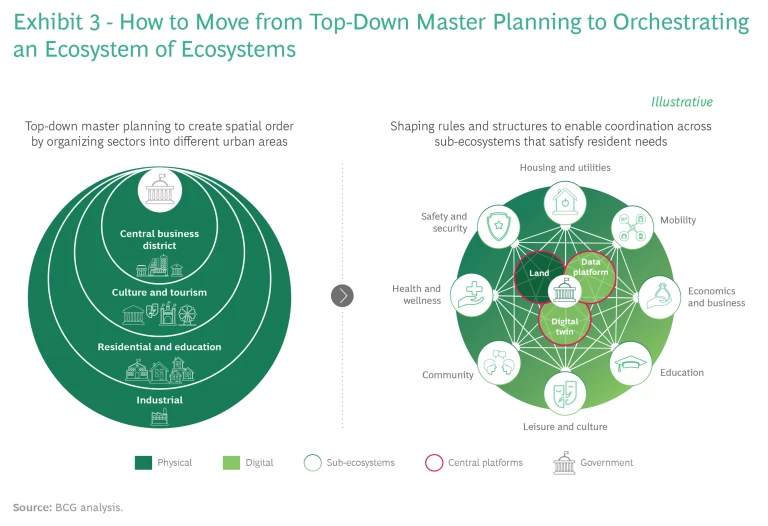Ecosystems are popular in business because they foster innovation, address complexity, scale quickly, and adapt to changing environments. They can do the same for cities.
The history of cities is the history of platforms. They started as places to buy and sell goods—trading platforms—and over time added new platforms to fulfill other needs, coordinate cooperation, and manage physical space. Streets and sidewalks (mobility platforms) enabled people to move between destinations, classrooms (educational platforms) brought children together to learn, and museums (cultural platforms) made art accessible to the public.
Platforms are a form of infrastructure—physical, digital, social, cultural, or hybrid—that facilitates interactions between parties. They generate value that increases with scale and intensity due to network effects. Cities now contain dozens of platforms, and these platforms have evolved and expanded to serve additional functions. Sidewalks became places for dining, music, and socializing. Schools and libraries began to serve as community centers and places to provide free lunches and other social services. And wireless networks have added digital functionality to these physical spaces as well as creating an entirely new platform. (See the slideshow.)
Cities now need to coordinate these multiple, interlocking platforms and functions as they seek to address vexing and complex issues such as overcrowding, housing shortages, economic development, public safety, inequality, and climate change. Their current governance model of master planning and vertical silos is no longer up to this task.
There is a better way.
Business have adopted the idea of platforms in a new powerful form, the digital ecosystem, to create such global giants as Airbnb, eBay, and Uber. If a platform is the stage, an ecosystem is the show—the full complement of actors, direction, and creativity. Ecosystems are popular in business because they foster innovation, scale quickly, and adapt to changing environments. They also allow many parties and actors to tackle complex problems from different angles. Ecosystems rely on an orchestrator to coordinate and shape, but not control, activity. Such coordination, rather than rigid top-down planning, is just what cities need today.
By returning to their roots, cities can revise their governance model to face their challenges. They can readopt the platform and its modern counterpart—the ecosystem—to address their most pressing social and economic issues, learning from businesses as they transition to this new governance model. Because cities are so complex, a single ecosystem will be insufficient. They will require an “ecosystem of ecosystems” approach.
Why Ecosystems Make Sense for Cities
Singapore, often touted as a model of effective urban planning, demonstrates the limitations of the current approach. Its 2013 Land Transport Master Plan 2013 promoted the use of bicycles, e-scooters, and other personal mobility devices for short trips. The city-state’s “Walk, Ride, Cycle” program encouraged commuters to leave their cars at home. Unsurprisingly, e-scooters quickly became a popular form of travel for commuters and especially food-delivery services.
But in late 2019, Singapore banned the use of e-scooters on footpaths when one hit and killed a 65-year-old bicyclist. The ban forced about 7,000 food-delivery scooters off the footpaths. The incident is emblematic of the tensions involving public health and safety, environmental protection, economic activity, and so on that occur when originally simple platforms house multiple uses. An ecosystem-of-ecosystems model can help cities work through these tensions by joining together relevant parties and issues rather than treating each in isolation.
The Challenges Facing Cities
City designers traditionally sought to create order, dividing cities into residential, business, and mixed-use districts and dividing governance into departments, agencies, and bureaucracies. Urban planner Le Corbusier declared order as one of the most fundamental human needs: “Space and light and order. Those are the things that men need just as much as they need bread or a place to sleep.” The size and scale of cities are presenting new and growing challenges, stretching their current governance model beyond its capabilities. Cities must address three major challenges to continue to thrive: complexity, uncertainty, and resident frustrations.
Complexity
As urban areas expand in many dimensions simultaneously, the challenges of managing them increase exponentially. Cities are increasingly tasked with fulfilling an expanding set of needs for their growing populations, and new platforms—physical, digital, and hybrid—are emerging to do so. At the same time, many of these platforms host multiple uses and activities occurring simultaneously. When COVID-19 shifted work and education online, for example, residents assumed multiple roles—employees, caretakers, and quasi-educators—inside suddenly crowded living spaces. Many were unable to keep up their performance in these numerous colliding functions.
Most of the tough challenges facing cities are multidimensional and require integrated, cross-functional solutions. Officials cannot solve issues of climate change, economic development, public safety, or social polarization within a single agency or department. Public safety, for example, is dependent not just on the police but also on social service and mental health agencies and even private actors, such as neighborhood and citizen groups. The siloed structure of current municipal governance creates policy and operational collisions and discourages the cooperation and coordination required to solve complex problems.
These collisions are becoming more common as cities continue to grow. The average population of the top 30 cities is projected to grow from 12 million in 2000 to 20 million in 2035 with a corresponding non-linear leap in complexity, straining the capacity of infrastructure in some cities. Prior to the pandemic, commuters in Tokyo, for example, routinely spent more than an hour and a half commuting each day on crowded mass transit lines and roadways.
Uncertainty
Traditional city planning is ill-suited for unpredictable and fast-evolving conditions, including “black swan” events that are occurring with greater frequency and severity. The multiyear, top-down planning cycle simply cannot accommodate the shifting and surging demands for municipal services and other amenities under these unanticipated challenges.
Climate and Environment. Extreme climate events are one example. In the world’s largest coastal cities, 100 million people and $5 trillion in assets are exposed to floods. The average number of annual flood events occurring in more than 30 US coastal cities was four times as high in the 2010s as it was in the 1970s. Inland cities are also facing weather extremes. In February 2021, temperatures dropped nearly 50°F below their typical low in Texas, causing massive power outages and nearly 250 deaths. Fewer than six months later, a heat wave in the Pacific Northwest caused more than 100 deaths.
Contagious Disease. Especially in the early days of COVID-19, cities bore the brunt of the pandemic’s worst effects. And they are likely to do so in the next crisis, which public health experts believe is inevitable in an age of global trade and travel. While cities cannot prevent the next health emergency, they can be better prepared than most Western metropolises were in 2020 to face it.
Rapidly Shifting Demand for Real Estate. The pandemic has accelerated an ongoing reallocation of physical space and reshuffling of real estate markets. Even before COVID struck, urban retail spaces were being repurposed as e-commerce fulfillment centers and streets were narrowing to accommodate dedicated bus and bicycle lanes. Many central business districts were incorporating more social and residential uses. Demand is rising for residential buildings—particularly affordable housing—with additional space and flexible formats to accommodate combined work and living facilities. Many projects will need to be revised and spaces repurposed during the planning and building stages.
Rapid Technological Innovation. The pace of innovation forces cities to try to adapt regulation and oversight on the fly. Ride-sharing, home-sharing, and online-delivery apps, for example, strain municipal resources and are forcing cities to govern new and expanding services under old regulations. The metaverse will likely be the next frontier where regulators will be playing catch-up.
Resident Frustrations
Residents expect cities to fulfill and to be responsive to their evolving needs—and most cities are struggling to keep up. Many of these expectations arise from the seamless experience offered by the digital realm. People accustomed to quick, positive transactions on a digital platform such as Amazon are increasingly frustrated with, for example, the cumbersome legacy process to renew a driver’s license. As we found in our Cities of Choice assessment, some cities are doing better than others in managing resident expectations. But even the highest-ranking cities have room to improve in fulfilling needs and resolving frustrations of their residents. London, the top-ranked city, scored only 66 out of a possible 100 and falls in the bottom half of the 45 cities evaluated on speed of change, one of the five measured dimensions. No city ranked in the top 40% across all five dimensions.
Low Trust in Authorities. Trust is one of the strongest levers for promoting sustainable development in cities. Yet only half of citizens in OECD countries reported having confidence in their national government in 2020. The pandemic has weakened trust in authorities and medical institutions. In the US, racial inequities have further decreased trust in law enforcement—starkly illustrated in the growth of the Black Lives Matter movement following the murder of George Floyd.
Speed of Change. Residents expect more from their government and companies in their ability to keep pace with change. For example, two-thirds of employees in the US want a permanent remote or hybrid work model, yet only about half of jobs in the US can be done remotely today. Residents are also looking for the public and private sector to practice environmental, social, and corporate governance. Nearly nine of ten respondents in a recent global BCG survey believe that private companies should increase their sustainability efforts.
What’s the Solution for Cities?
Whatever their flaws, cities remain places where people want to live, work, and interact. Properly harnessed, their size and scale can enable efficiency, opportunity, and innovation not available in rural and suburban communities. Residents who fled them during the pandemic are returning. Real-life, physical experiences will also help cities maintain an edge over the metaverse, which explains why such companies as Google, Amazon, and Meta are making major investments in office space in key cities even as they build and promote their technologies.
The governance of cities has been constantly evolving from their early days as a platform. It’s time to take the next step into an ecosystem of ecosystems. (See Exhibit 2.) This model has many advantages over traditional city governance in addressing complexity, uncertainty, and resident frustration:
- Ecosystems can address complexity by bringing together many disciplines and approaches and forcing parties inside and outside of government to work together to solve multidimensional challenges such as economic development or public safety. This cooperation is hard to come by within the vertical silos of municipal governments. Likewise, the orchestration model of ecosystems is well suited for modern cities that are too sprawling and interconnected to micromanage.
- Ecosystems can address uncertainty through evolution and adaptation. As circumstances change, independent actors in the ecosystem can respond in parallel rather than waiting for centralized direction and instruction from a slow bureaucracy.
- Finally, ecosystems address residents’ frustrations by doing a better job of matching supply and demand. Decision makers are close to the market, so they have a better understanding of evolving needs than city bureaucrats.
While most business ecosystems are built around a central platform, cities are not so simple. Multiple overlapping platforms and ecosystems already exist and must collaborate for the city to function as an effective, cohesive architecture. The economic development ecosystem, for example, hinges on affordable housing, strong public education, and functioning mass transit.
Accordingly, cities must orchestrate an ecosystem of ecosystems that emphasizes coordination across existing new and existing sub-ecosystems spanning physical and digital realms and addressing the needs of many parties with many roles. Cities will need to invest in several key central platforms—not just land, but also data platforms and digital twins (virtual representations of physical objects and systems)—to facilitate such coordination. (See Exhibit 3.)
This model will take many years to implement. But cities can start building its core components right away. Administrations can shift their focus from centralized planning to fulfilling residents’ needs. They can hire fewer planners and more coordinators who can work across ecosystems and platforms. And they can focus more on common standards rather than static rules.
These things are all positive steps that can be taken within the confines of existing city governance. But they won’t fundamentally alter the delivery of public services or prevent collisions of competing interests over shared space. To govern a city through ecosystems, officials should look to the private sector for inspiration and instruction. Modern corporate digital platforms and ecosystems offer several lessons.
Decide What to Control and What to Orchestrate
One of the strengths of ecosystems is that their orchestrators don’t do everything. They support the ecosystem by developing key central platforms and connective tissue enabling coordination across it. They also identify and partner with other parties to fulfill specific functions and services. Singapore’s SkillsFuture program, for example, provides adults with S$500 to support lifelong learning and training. Run by the government, SkillsFuture relies on a range of schools, private companies, and other partners to provide the courses themselves.
Focus on Addressing Big Problems
Ecosystems are unnecessary for relatively simple, straightforward problems. Cities do not need an ecosystem to, for instance, construct a road between two destinations. Urban mobility solutions, however, present a major opportunity to apply an ecosystem model. By coordinating public and private players, cities will be able to create more integrated transport networks. Mobility applications from Lyft to Vienna’s WienMobil app, for example, help travelers move through the city seamlessly by suggesting multiple route options across different modes of transportation and showing sustainability metrics by route.
Define Ecosystem-Wide Standards
Cities will not be able to control all components of the ecosystems under their domain, but they need to establish standards by which parties must abide. Each administration needs to determine key elements to standardize across its own ecosystems. Potential candidates include:
Goals. Cities should establish clear overarching goals and problems that the underlying ecosystems are seeking to achieve and solve. Here are four:
- Resident centricity—the idea that the city ecosystem exists to serve the needs of residents in their many roles
- Equity and inclusion, aiming to support underserved members of society
- Sustainability—and a commitment to work across the ecosystem to achieve it
- Accountability as a tool to expose wrongdoing, share best practices, and build trust
Standards of Conduct. All parties to an ecosystem should abide by common rules of engagement, especially data governance, so that their work is shareable, replicable, and trustworthy. Residents, for example, need to know that their personal data is being properly managed and not subject to abuse. Cities might also want to require parties in an ecosystem to create plug-and-play modularity to their technology so that other parties can build on it.
Representation, Feedback, and Engagement. To become resident centric, cities need to understand what residents think and want. They should tap into the power of digital technology to gather input and feedback, and even solicit innovative ideas from their residents. Trust is a byproduct of this type of distributed democracy. Paris’s Dans Ma Rue (“On My Street”) program, for example, allows residents to report dirty or unsafe streets. Singapore’s OneService app allows residents to give feedback on a municipal service without navigating the kaleidoscope of agencies responsible for solving it.
Measuring and Tracking Performance. Cities can develop an intuitive set of metrics that show traditional performance in areas such as government efficiency and economic growth but also provide a more comprehensive view of a city’s ability to fulfil its residents’ needs. One way to do this is by tracking new KPIs such as distribution of political power, equity, sustainability, and resident satisfaction.
Facilitate Cooperation and Modularity
An ecosystem of ecosystems approach essentially flips the current governance model of cities on its side, shifting the focus from top-down centralized planning of space to orchestrating collaboration among ecosystems. Cross-agency initiatives often get stuck in the machinery of government or buried by multiple agencies’ governance requirements. An ecosystem approach could help break down barriers separating vertical agencies by creating cross-agency teams, enforcing common data governance standards, and measuring progress against broad goals requiring active engagement across agencies.
Build Coordinating Elements, Including Central Platforms
In a resident-centric ecosystem of ecosystems, one of the city’s primary roles will be to encourage cooperation and coordination among private and public parties and to facilitate seamless resident journeys. To do so, cities will need to create coordinating elements, especially central data platforms and digital identification.
These central data platforms should be governed by standards that include ensuring data created by one party is accessible to others in the ecosystem. The London Datastore, for example, provides access to 700 sets of data to help residents, businesses, developers, or researchers analyze and build solutions to the city’s problems. During the pandemic, for example, researchers relied heavily on the London Datastore to develop models.
Another key area of innovation in the public sector builds on the success of business in using marketing technology to create unique digital identities. Estonia’s electronic identity system, called eID, can be used for dozens of public and private services and requires coordination across an ecosystem of public agencies and private vendors. Residents use their eIDs to pay bills, vote online, sign contracts, pay taxes, access healthcare, and more.
Recent technological innovations have made digital twins available to cities as another central platform to facilitate horizontal coordination. By consolidating inputs from all parties in an ecosystem into a single model, cities can engage in scenario planning and other advanced analytics that no one party could do alone. Shanghai and Wellington, New Zealand, have both developed digital twins of their cities for this purpose.
Land and public spaces will still constitute central platforms of cities, but they will share the spotlight with a much richer set of other ecosystem components and players.
Evolve Continually
Current regulations and policies are not well suited for an ecosystems of ecosystems approach. They are too static, prescriptive, siloed, and tied to past practices. For this new approach to take hold, cities need to develop dynamic and flexible rule making. A critical benefit of an ecosystem strategy is the ability to adapt quickly to changing situations and evolve to face new challenges. This capability must be embedded in the city’s governance model.
The ecosystems themselves also need to evolve, both in how they operate and the services and activities they provide. One of the reasons ecosystems work is that they are readily responsive to shifting circumstances, a key benefit over the bureaucracy they are meant to replace.
Orchestrating an ecosystem of ecosystems may be a radical change in approach but it is a necessary one. Traditional urban planning and governance models have outlived their usefulness. Cities came into existence as platforms. They should march into the future as modern versions of an innovation that they pioneered.










